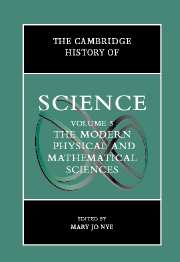Book contents
- Frontmatter
- Introduction: The Modern Physical and Mathematical Sciences
- Part I The Public Cultures of the Physical Sciences After 1800
- Part II Discipline Building in the Sciences: Places, Instruments, Communication
- 6 Mathematical Schools, Communities, and Networks
- 7 The Industry, Research, and Education Nexus
- 8 Remaking Astronomy: Instruments and Practice in the Nineteenth and Twentieth Centuries
- 9 Languages in Chemistry
- 10 Imagery And Representation In Twentieth-Century Physics
- Part III Chemistry and Physics: Problems Through the Early 1900s
- Part IV Atomic and Molecular Sciences in the Twentieth Century
- Part V Mathematics, Astronomy, and Cosmology Since the Eighteenth Century
- Part VI Problems and Promises at the End of the Twentieth Century
- Index
- References
10 - Imagery And Representation In Twentieth-Century Physics
from Part II - Discipline Building in the Sciences: Places, Instruments, Communication
Published online by Cambridge University Press: 28 March 2008
- Frontmatter
- Introduction: The Modern Physical and Mathematical Sciences
- Part I The Public Cultures of the Physical Sciences After 1800
- Part II Discipline Building in the Sciences: Places, Instruments, Communication
- 6 Mathematical Schools, Communities, and Networks
- 7 The Industry, Research, and Education Nexus
- 8 Remaking Astronomy: Instruments and Practice in the Nineteenth and Twentieth Centuries
- 9 Languages in Chemistry
- 10 Imagery And Representation In Twentieth-Century Physics
- Part III Chemistry and Physics: Problems Through the Early 1900s
- Part IV Atomic and Molecular Sciences in the Twentieth Century
- Part V Mathematics, Astronomy, and Cosmology Since the Eighteenth Century
- Part VI Problems and Promises at the End of the Twentieth Century
- Index
- References
Summary
Scientists have always expressed a strong urge to think in visual images, especially today with our new and exciting possibilities for the visual display of information. We can “see” elementary particles in bubble chamber photographs. But what is the deep structure of these images? A basic problem in modern science has always been how to represent nature, both visible and invisible, with mathematics, and how to understand what these representations mean. This line of inquiry throws fresh light on the connection between common sense intuition and scientific intuition, the nature of scientific creativity, and the role played by metaphors in scientific research.
We understand, and represent, the world about us not merely through perception but with the complex interplay between perception and cognition. Representing phenomena means literally re-presenting them as either text or visual image, or a combination of the two. But what exactly are we re-presenting? What sort of visual imagery should we use to represent phenomena? Should we worry that visual imagery can be misleading?
Consider Figure 10.1, which shows the visual image offered by Aristotelian physics for a cannonball’s trajectory. It is drawn with a commonsensical Aristotelian intuition in mind. On the other hand, Galileo Galilei (1564–1642) realized that specific motions should not be imposed on nature. Rather, they should emerge from the theory’s mathematics – in this way should the book of nature be read. Figure 10.2 is Galileo’s own drawing of the parabolic fall of an object pushed horizontally off a table. It contains the noncommonsensical axiom of his new physics that all objects fall with the same acceleration, regardless of their weight, in a vacuum.
- Type
- Chapter
- Information
- The Cambridge History of Science , pp. 191 - 216Publisher: Cambridge University PressPrint publication year: 2002



